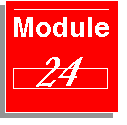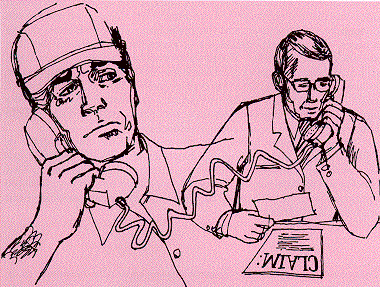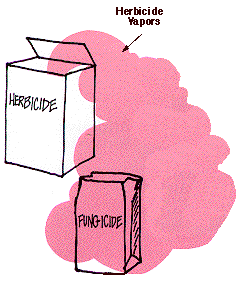Liability

Liability
Almost all pesticides are considered hazardous. Even the most careful
applicators sometimes have damage claims brought against them. The usual claims
are for nonperformance, misapplication, crop injury, property damage, and/or
contamination of non-target areas. It is important for all certified applicators
to be informed of the most common claims which could be brought against them.

Goals of This Chapter
- Recognize and understand the liability issues of incorrect application
procedures.
- Learn the steps you should take to protect yourself against pesticide misuse
suits.
- Understand the importance of insurance.
Drift
Drifting pesticides are a major cause of environmental contamination and damage
to non-target areas. In general, the courts have held the pesticide applicator
and the customer who hired him jointly liable in drift cases. The customer is
responsible when he hires or contracts for a "particularly dangerous operation"
such as the application of pesticides. However, don't depend on the customer to
share costs. He may file another suit against you claiming that you agreed not
to cause drift damage. In certain instances, the manufacturer of the pesticide
may also be held liable. If the label does not clearly warn about the
possibility of drift, the manufacturer may share liability.
 Would you like to try a study question?
Would you like to try a study question?
Target Site
Claims of injury to the target site (crop, turf, shrub, etc.) that was treated
or claims that the pesticide had not performed as expected involve the dealer,
the manufacturer, and the applicator. The courts must decide which of the three
recommended or guaranteed the product for that specific use on that target. The
party in error must accept the blame and pay damages. Applicators must make sure
that all pesticides they use are recommended on the label for that purpose.
Detailed records of all pesticide applications can be used in this circumstance
to support the applicators' claim of proper pesticide use. Then, and only then,
may the blame possibly be placed on the manufacturer.
 Would you like to try a study question?
Would you like to try a study question?
If the target site injury was not great or total, the customer or applicator
must show how much damage was from the pesticide and how much was from other
conditions such as weather, disease, etc. This breakdown is not necessary in
cases with great or total injury. Both the applicator and customer may be held
liable for injury resulting from negligent application.
Personal Injury
The application of pesticides is considered an especially dangerous or, in legal
terms, an "ultra-hazardous" activity. As a result, the pesticide applicator is
liable for any injury to a person from the pesticide. Usually the injured person
can recover damages without proving negligence of the applicator. The injured
party must only prove that he is free of any negligence and did not assume the
risk of pesticide exposure. The liability in most cases involving personal
injury or death depends on proving the applicator negligent.
 Would you like to try a study question?
Would you like to try a study question?
Wrong Site
If the pesticide is applied on a field, crop, or area other than the one it was
intended for, serious problems can result. In the event that damage or
over-tolerance occurs or that the owner just didn't want the area treated, the
applicator may be charged with negligent application. Defense is very difficult.
Double check on addresses, site locations, and all landmarks before you treat an
area. Applying pesticides to the wrong site can be very costly.
 Would you like to try a study question?
Would you like to try a study question?
Bees
Honeybees are very important to the farmer and often he has his own colonies or
hives. However, bees are insects and are very susceptible to many pesticides. If
the bees in hives are killed as the result of drift from nearby application
sites, the applicator can be held legally responsible and must pay for damages.
In some states an applicator is liable only if he fails to notify adjacent
landowners prior to the pesticide application. Some states require notification
of registered beekeepers prior to applications in the vicinity of beehives.
Check your state regulations for this requirement.

However, if bees are exposed to the pesticides while in the sprayed site, the
applicator is not usually liable. Unless the applicator has ignored a label
direction that specifically would have protected the bees, the courts have ruled
that the bee is trespassing and that the land doesn't need to be safe to
uninvited animals. Play it safe! Know where the beehives are located in your
area. Warn the beekeeper beforehand when and where you will be spraying.
 Would you like to try a study question?
Would you like to try a study question?
Attractive Nuisance
The rulings on "attractive nuisance" usually involve cases where children are
attracted to ground equipment or aircraft and injure themselves. The owner
and/or applicator are held liable for injuries caused to children, even if they
are trespassing, when the landowner fails to take reasonable precautions to
prevent injuries from dangerous equipment which can be attractive to children.
In order for a precaution to be reasonable, children must frequent an area so
that the landowner expects their presence.
Therefore, beware! Do not leave ground equipment with exposed drive belts, drive
wheels, gears, or any moving parts unattended in areas where children can get to
them. Aircraft should never be parked where curious children can find them.
Pesticides in unlocked or open vehicles should never be left unattended. Empty
containers and aerosol cans are also attractive and dangerous to
children. Store and dispose of them properly!
 Would you like to try a study question?
Would you like to try a study question?
Noise
Recently claims have been brought against applicators for noise damage. Home
owners, as well as others, have claimed damage or loss of property value caused
by noise of aircraft and ground equipment operating above or near their
property. They must prove direct loss of property due to noise from machinery
operated carelessly or negligently. In some cases, an owner will claim that an
applicator made an unlawful flight over his property without his permission.
This is especially important in aerial applications when pull-ups over nearby
property are necessary. Applicators and owners are legally liable only if the
noise created is excessive or unreasonable. Reasonable noise is not legally a
nuisance, even though it may be irritating. Successful defense is possible when
the applicator can show that the noise wasn't the cause of injury or that no
damage occurred.
Cross Contamination
Every year there are cases of pesticide cross contamination reported which may
damage the sites being treated. There are three ways that this may occur:
- The applicator may make an error in mixing or filling in the spray tank. He may
not have removed all the pesticide left over from the last application. In this
case, both the applicator and owner may be liable.
- Open containers of herbicides such as 2,4-D can vaporize (become a gas) and
penetrate other pesticides which are stored nearby. When other pesticides are
applied, a 2,4-D contamination can seriously injure the site.
- The manufacturer may make a mistake in labeling, formulating, or refilling a
container.
The applicator must know which container of pesticide was used on the site so
that laboratory tests can be made. The lab tests can show whether the
contamination occurred during mixing and filling or earlier. In cases involving
herbicide contamination, it is difficult to prove whether it is the result of
vaporization during storage or manufacturer error. The courts must decide who is
to blame.

NOTE:All applicators should write the location and the date
that the pesticide was applied on the label of each pesticide container. They
should also record the lot number in case cross contamination does occur.
Detailed records of every application should be kept.
What To Do When You Are Involved
If you become involved in any legal problem, act carefully and promptly. Always
be friendly and helpful. Never admit liability. Be careful whom you give
information to about your spray operation. Offer to look into the matter
immediately.
- Examine your records to make sure that you were actually operating in the area
at the time of the alleged injury.
- Make sure that all of your records are up-to-date, particularly as to the
identity of the equipment used, temperatures, wind direction and velocity, and
all other pertinent data.
- Proceed to the scene immediately and make notes of all essential information
when you get there.
- Record the presence of any adverse condition that you observed at the time of
your investigation, particularly insect infestations, disease, water stress,
late planting, and carry-over effect from any other materials that may have been
used.
- Photograph, using color film and a sufficiently close focal length, any adverse
condition found so that the symptoms can be examined by an expert.
- Save the container that was used in the job. If it is not practical to save the
whole container, save the label or use close-up color photography to record the
label.
- Notify your insurance company immediately.
- If you do not have insurance for the loss involved, request permission to have
an expert examine the site or the property, so that you may have the benefit of
his opinions.
- If a chemical company is involved, notify them immediately. They will probably
also want to send their experts to the site.
- Obtain the names and addresses of all witnesses who might testify to the nature
of the operation and conditions of the site before and after. In the event that
the site of application is perennial, examine the USDA aerial photographs to
ascertain the condition of the orchard or other perennial plantings in years
prior to the year of alleged injury.
 Would you like to try a study question?
Would you like to try a study question?
Insurance
To protect yourself and your business you, as a pesticide applicator, should
have insurance for possible pesticide mishaps. Some states have insurance
requirements. It is now required in some states to list your insurance company
on the pesticide certification application, before it is valid. There are many
different types of insurance plans, they include bodily injury, property damage,
restricted chemical liability and comprehensive chemical. The plan you choose
should fit your needs and your business. Be sure to explore the costs, benefits,
and drawbacks of each insurance plan before you buy. You need to know exactly
what your coverage includes. An insurance agent who specializes in pesticide
insurance is the best person to advise you on your individual insurance needs.
 Would you like to try a study question?
Would you like to try a study question?
Public Relations
It is always important to maintain a good public image as a pesticide
applicator. Here are some things to consider:
- Always be courteous. First impressions can often be long lasting. Calm words
help to open future discussion.
- Listen to the question. Let the person know that you understand the basis for
his or her concern.
- Be prepared. Applicators should know what materials are being applied, why they
are being applied, and what its basic characteristics are. Keep accurate
records.
- Have an answer. Be as informed as possible and do not give information you are
not sure of.
- Take information. Include name, location, date, time and details of the
situation and request for information.
- Be prompt. Problems may come up during the busiest times, but dealing with them
as quickly as possible may make the difference between an easy solution or a
complicated expensive one.
- Keep good records. A simple file that includes inquiries and course of action
taken may prove to be important documentation.
 Would you like to try a study question?
Would you like to try a study question?
No matter how careful you are, accidents will happen. You must be prepared
for any emergency. Above all, keep calm.
Back to Top